Organisational Behaviour and Design: Leadership Perception Essay
VerifiedAdded on 2021/04/17
|9
|3052
|24
Essay
AI Summary
This essay delves into the significant impact of perception on leadership effectiveness within organizational settings. It defines perception as the way individuals interpret and understand situations, emphasizing its crucial role in shaping leadership styles and influencing employee behaviour. The essay explores how a leader's personality, communication skills, and ability to understand employee perspectives directly affect their perceived effectiveness. It highlights that positive employee perceptions are vital for a leader's success, as they influence how employees respond to direction and view the leader's actions. The essay discusses various factors influencing perception, such as communication, empathy, cultural sensitivity, and the avoidance of stereotyping, while providing strategies for leaders to improve employee perceptions. The conclusion reinforces the importance of self-awareness, effective communication, and a positive approach in enhancing leadership effectiveness, stressing that the success of a leader is closely tied to the perceptions of their subordinates.
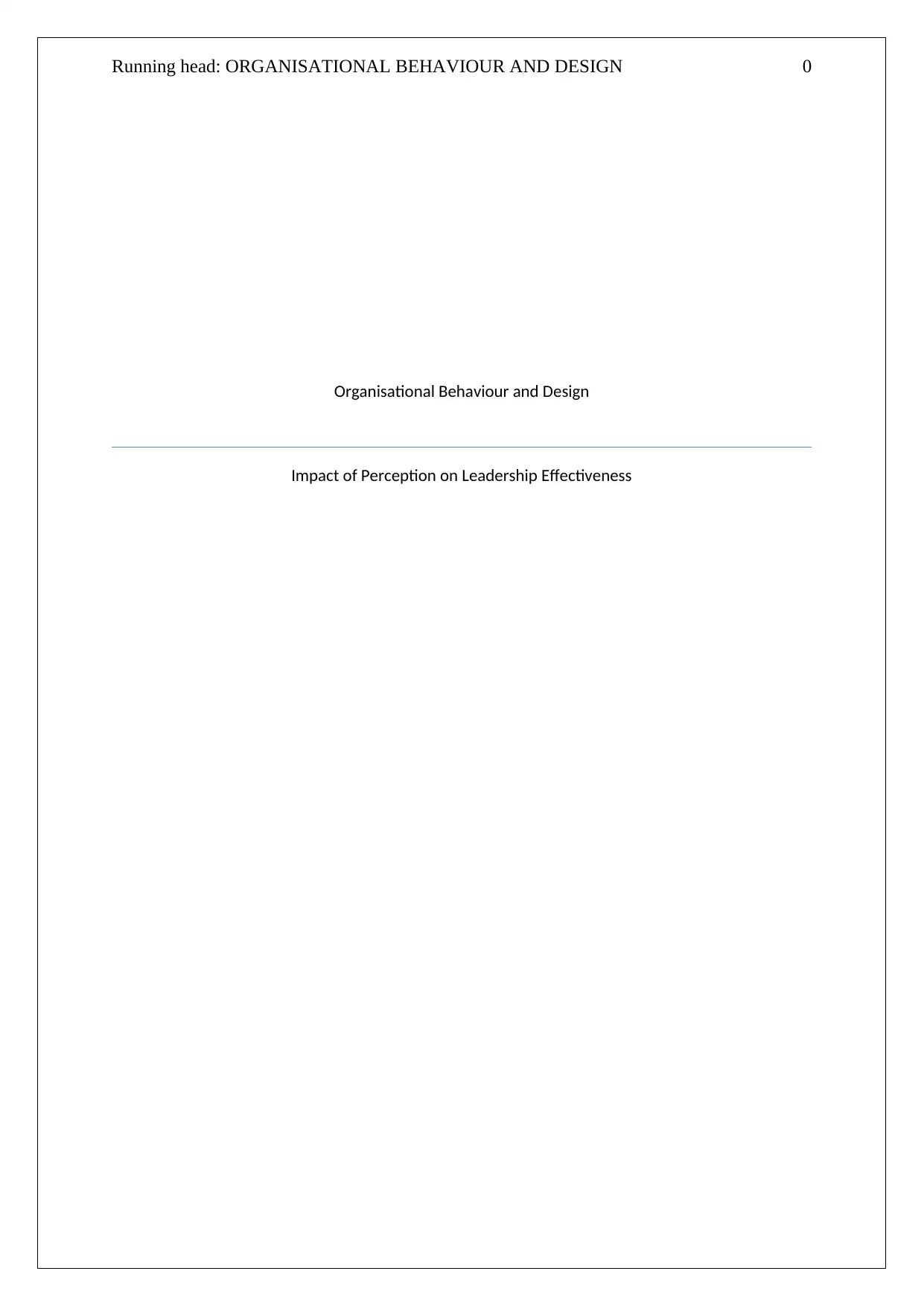
Running head: ORGANISATIONAL BEHAVIOUR AND DESIGN 0
Organisational Behaviour and Design
Impact of Perception on Leadership Effectiveness
Organisational Behaviour and Design
Impact of Perception on Leadership Effectiveness
Paraphrase This Document
Need a fresh take? Get an instant paraphrase of this document with our AI Paraphraser
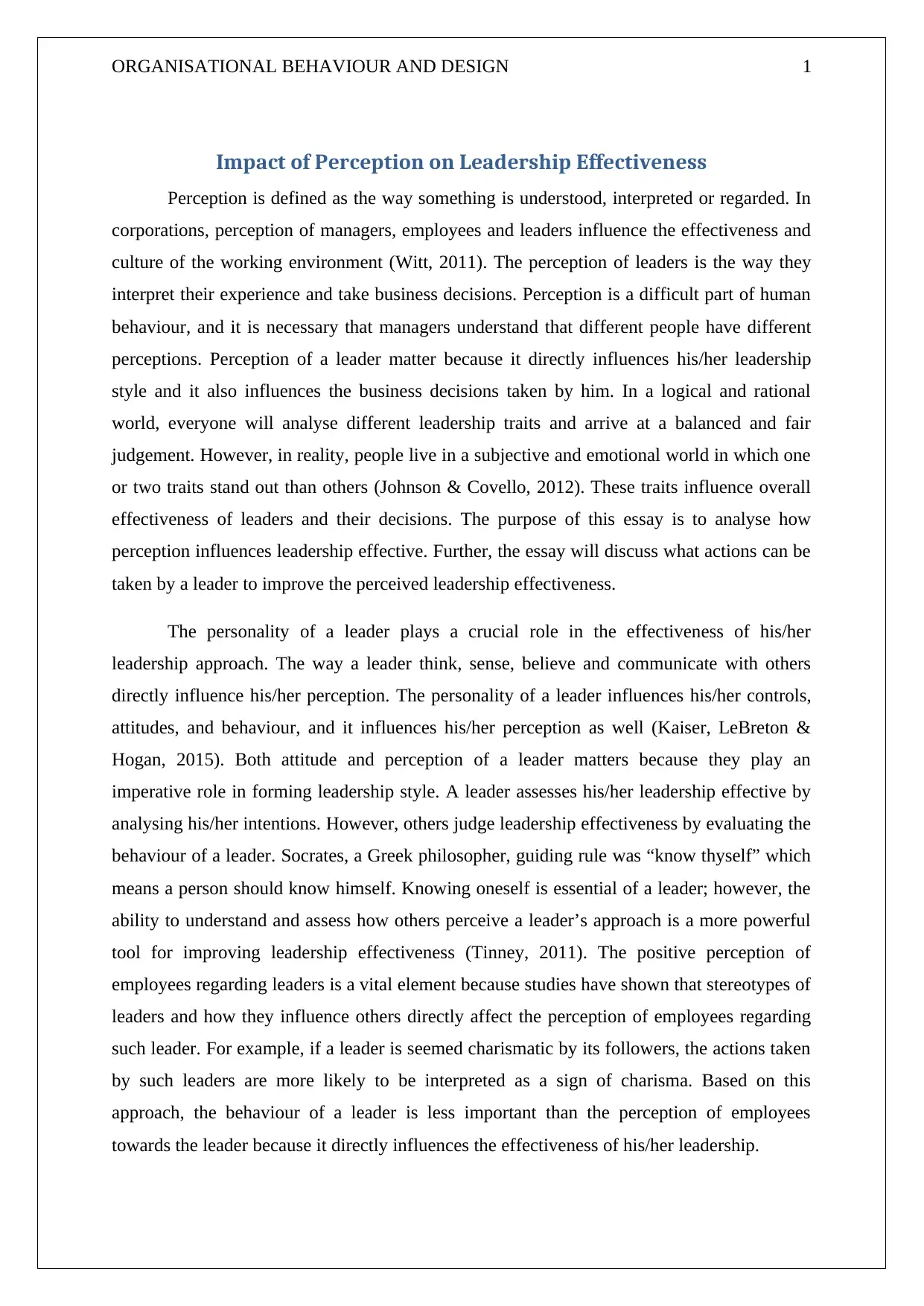
ORGANISATIONAL BEHAVIOUR AND DESIGN 1
Impact of Perception on Leadership Effectiveness
Perception is defined as the way something is understood, interpreted or regarded. In
corporations, perception of managers, employees and leaders influence the effectiveness and
culture of the working environment (Witt, 2011). The perception of leaders is the way they
interpret their experience and take business decisions. Perception is a difficult part of human
behaviour, and it is necessary that managers understand that different people have different
perceptions. Perception of a leader matter because it directly influences his/her leadership
style and it also influences the business decisions taken by him. In a logical and rational
world, everyone will analyse different leadership traits and arrive at a balanced and fair
judgement. However, in reality, people live in a subjective and emotional world in which one
or two traits stand out than others (Johnson & Covello, 2012). These traits influence overall
effectiveness of leaders and their decisions. The purpose of this essay is to analyse how
perception influences leadership effective. Further, the essay will discuss what actions can be
taken by a leader to improve the perceived leadership effectiveness.
The personality of a leader plays a crucial role in the effectiveness of his/her
leadership approach. The way a leader think, sense, believe and communicate with others
directly influence his/her perception. The personality of a leader influences his/her controls,
attitudes, and behaviour, and it influences his/her perception as well (Kaiser, LeBreton &
Hogan, 2015). Both attitude and perception of a leader matters because they play an
imperative role in forming leadership style. A leader assesses his/her leadership effective by
analysing his/her intentions. However, others judge leadership effectiveness by evaluating the
behaviour of a leader. Socrates, a Greek philosopher, guiding rule was “know thyself” which
means a person should know himself. Knowing oneself is essential of a leader; however, the
ability to understand and assess how others perceive a leader’s approach is a more powerful
tool for improving leadership effectiveness (Tinney, 2011). The positive perception of
employees regarding leaders is a vital element because studies have shown that stereotypes of
leaders and how they influence others directly affect the perception of employees regarding
such leader. For example, if a leader is seemed charismatic by its followers, the actions taken
by such leaders are more likely to be interpreted as a sign of charisma. Based on this
approach, the behaviour of a leader is less important than the perception of employees
towards the leader because it directly influences the effectiveness of his/her leadership.
Impact of Perception on Leadership Effectiveness
Perception is defined as the way something is understood, interpreted or regarded. In
corporations, perception of managers, employees and leaders influence the effectiveness and
culture of the working environment (Witt, 2011). The perception of leaders is the way they
interpret their experience and take business decisions. Perception is a difficult part of human
behaviour, and it is necessary that managers understand that different people have different
perceptions. Perception of a leader matter because it directly influences his/her leadership
style and it also influences the business decisions taken by him. In a logical and rational
world, everyone will analyse different leadership traits and arrive at a balanced and fair
judgement. However, in reality, people live in a subjective and emotional world in which one
or two traits stand out than others (Johnson & Covello, 2012). These traits influence overall
effectiveness of leaders and their decisions. The purpose of this essay is to analyse how
perception influences leadership effective. Further, the essay will discuss what actions can be
taken by a leader to improve the perceived leadership effectiveness.
The personality of a leader plays a crucial role in the effectiveness of his/her
leadership approach. The way a leader think, sense, believe and communicate with others
directly influence his/her perception. The personality of a leader influences his/her controls,
attitudes, and behaviour, and it influences his/her perception as well (Kaiser, LeBreton &
Hogan, 2015). Both attitude and perception of a leader matters because they play an
imperative role in forming leadership style. A leader assesses his/her leadership effective by
analysing his/her intentions. However, others judge leadership effectiveness by evaluating the
behaviour of a leader. Socrates, a Greek philosopher, guiding rule was “know thyself” which
means a person should know himself. Knowing oneself is essential of a leader; however, the
ability to understand and assess how others perceive a leader’s approach is a more powerful
tool for improving leadership effectiveness (Tinney, 2011). The positive perception of
employees regarding leaders is a vital element because studies have shown that stereotypes of
leaders and how they influence others directly affect the perception of employees regarding
such leader. For example, if a leader is seemed charismatic by its followers, the actions taken
by such leaders are more likely to be interpreted as a sign of charisma. Based on this
approach, the behaviour of a leader is less important than the perception of employees
towards the leader because it directly influences the effectiveness of his/her leadership.
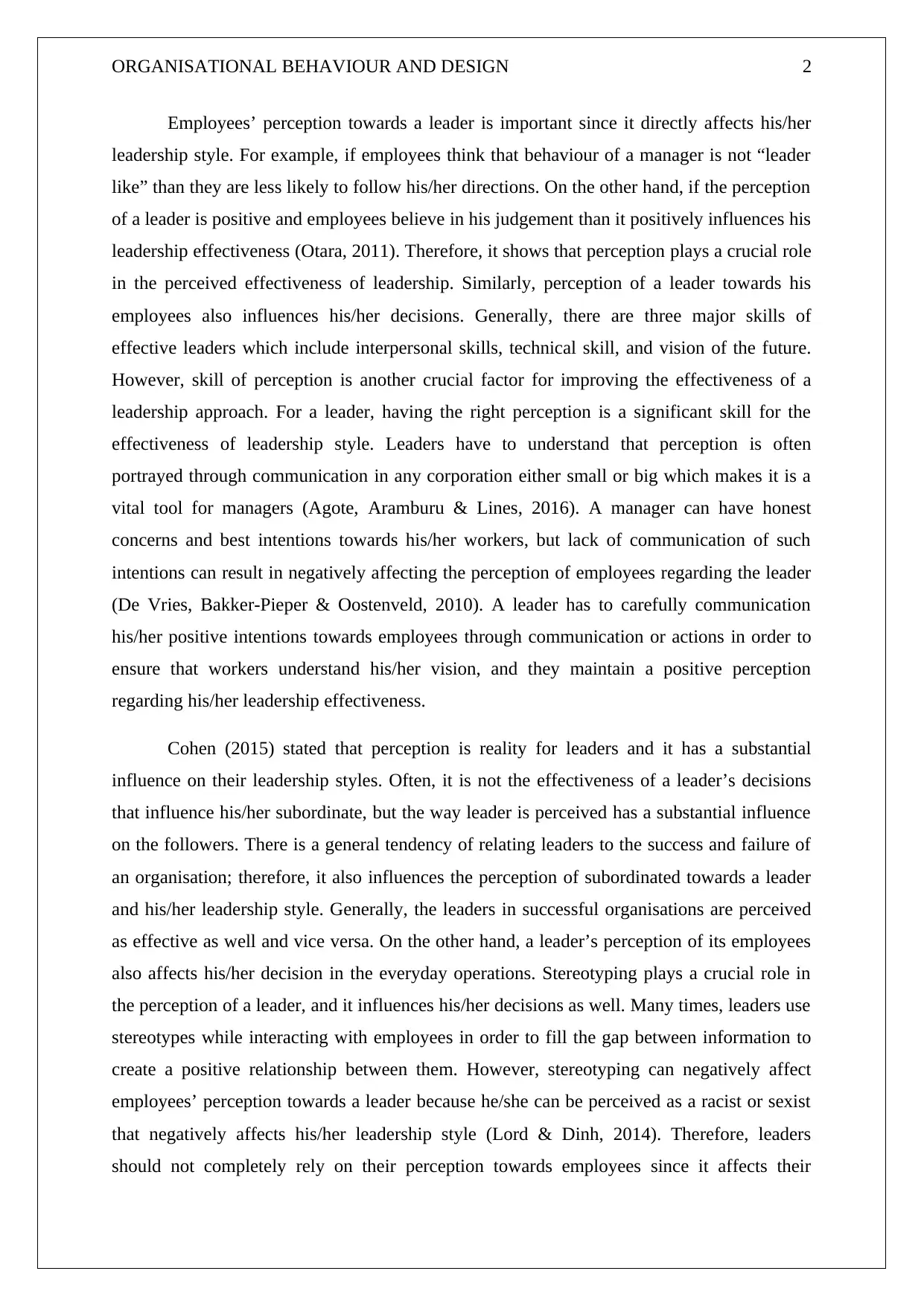
ORGANISATIONAL BEHAVIOUR AND DESIGN 2
Employees’ perception towards a leader is important since it directly affects his/her
leadership style. For example, if employees think that behaviour of a manager is not “leader
like” than they are less likely to follow his/her directions. On the other hand, if the perception
of a leader is positive and employees believe in his judgement than it positively influences his
leadership effectiveness (Otara, 2011). Therefore, it shows that perception plays a crucial role
in the perceived effectiveness of leadership. Similarly, perception of a leader towards his
employees also influences his/her decisions. Generally, there are three major skills of
effective leaders which include interpersonal skills, technical skill, and vision of the future.
However, skill of perception is another crucial factor for improving the effectiveness of a
leadership approach. For a leader, having the right perception is a significant skill for the
effectiveness of leadership style. Leaders have to understand that perception is often
portrayed through communication in any corporation either small or big which makes it is a
vital tool for managers (Agote, Aramburu & Lines, 2016). A manager can have honest
concerns and best intentions towards his/her workers, but lack of communication of such
intentions can result in negatively affecting the perception of employees regarding the leader
(De Vries, Bakker-Pieper & Oostenveld, 2010). A leader has to carefully communication
his/her positive intentions towards employees through communication or actions in order to
ensure that workers understand his/her vision, and they maintain a positive perception
regarding his/her leadership effectiveness.
Cohen (2015) stated that perception is reality for leaders and it has a substantial
influence on their leadership styles. Often, it is not the effectiveness of a leader’s decisions
that influence his/her subordinate, but the way leader is perceived has a substantial influence
on the followers. There is a general tendency of relating leaders to the success and failure of
an organisation; therefore, it also influences the perception of subordinated towards a leader
and his/her leadership style. Generally, the leaders in successful organisations are perceived
as effective as well and vice versa. On the other hand, a leader’s perception of its employees
also affects his/her decision in the everyday operations. Stereotyping plays a crucial role in
the perception of a leader, and it influences his/her decisions as well. Many times, leaders use
stereotypes while interacting with employees in order to fill the gap between information to
create a positive relationship between them. However, stereotyping can negatively affect
employees’ perception towards a leader because he/she can be perceived as a racist or sexist
that negatively affects his/her leadership style (Lord & Dinh, 2014). Therefore, leaders
should not completely rely on their perception towards employees since it affects their
Employees’ perception towards a leader is important since it directly affects his/her
leadership style. For example, if employees think that behaviour of a manager is not “leader
like” than they are less likely to follow his/her directions. On the other hand, if the perception
of a leader is positive and employees believe in his judgement than it positively influences his
leadership effectiveness (Otara, 2011). Therefore, it shows that perception plays a crucial role
in the perceived effectiveness of leadership. Similarly, perception of a leader towards his
employees also influences his/her decisions. Generally, there are three major skills of
effective leaders which include interpersonal skills, technical skill, and vision of the future.
However, skill of perception is another crucial factor for improving the effectiveness of a
leadership approach. For a leader, having the right perception is a significant skill for the
effectiveness of leadership style. Leaders have to understand that perception is often
portrayed through communication in any corporation either small or big which makes it is a
vital tool for managers (Agote, Aramburu & Lines, 2016). A manager can have honest
concerns and best intentions towards his/her workers, but lack of communication of such
intentions can result in negatively affecting the perception of employees regarding the leader
(De Vries, Bakker-Pieper & Oostenveld, 2010). A leader has to carefully communication
his/her positive intentions towards employees through communication or actions in order to
ensure that workers understand his/her vision, and they maintain a positive perception
regarding his/her leadership effectiveness.
Cohen (2015) stated that perception is reality for leaders and it has a substantial
influence on their leadership styles. Often, it is not the effectiveness of a leader’s decisions
that influence his/her subordinate, but the way leader is perceived has a substantial influence
on the followers. There is a general tendency of relating leaders to the success and failure of
an organisation; therefore, it also influences the perception of subordinated towards a leader
and his/her leadership style. Generally, the leaders in successful organisations are perceived
as effective as well and vice versa. On the other hand, a leader’s perception of its employees
also affects his/her decision in the everyday operations. Stereotyping plays a crucial role in
the perception of a leader, and it influences his/her decisions as well. Many times, leaders use
stereotypes while interacting with employees in order to fill the gap between information to
create a positive relationship between them. However, stereotyping can negatively affect
employees’ perception towards a leader because he/she can be perceived as a racist or sexist
that negatively affects his/her leadership style (Lord & Dinh, 2014). Therefore, leaders
should not completely rely on their perception towards employees since it affects their
⊘ This is a preview!⊘
Do you want full access?
Subscribe today to unlock all pages.

Trusted by 1+ million students worldwide
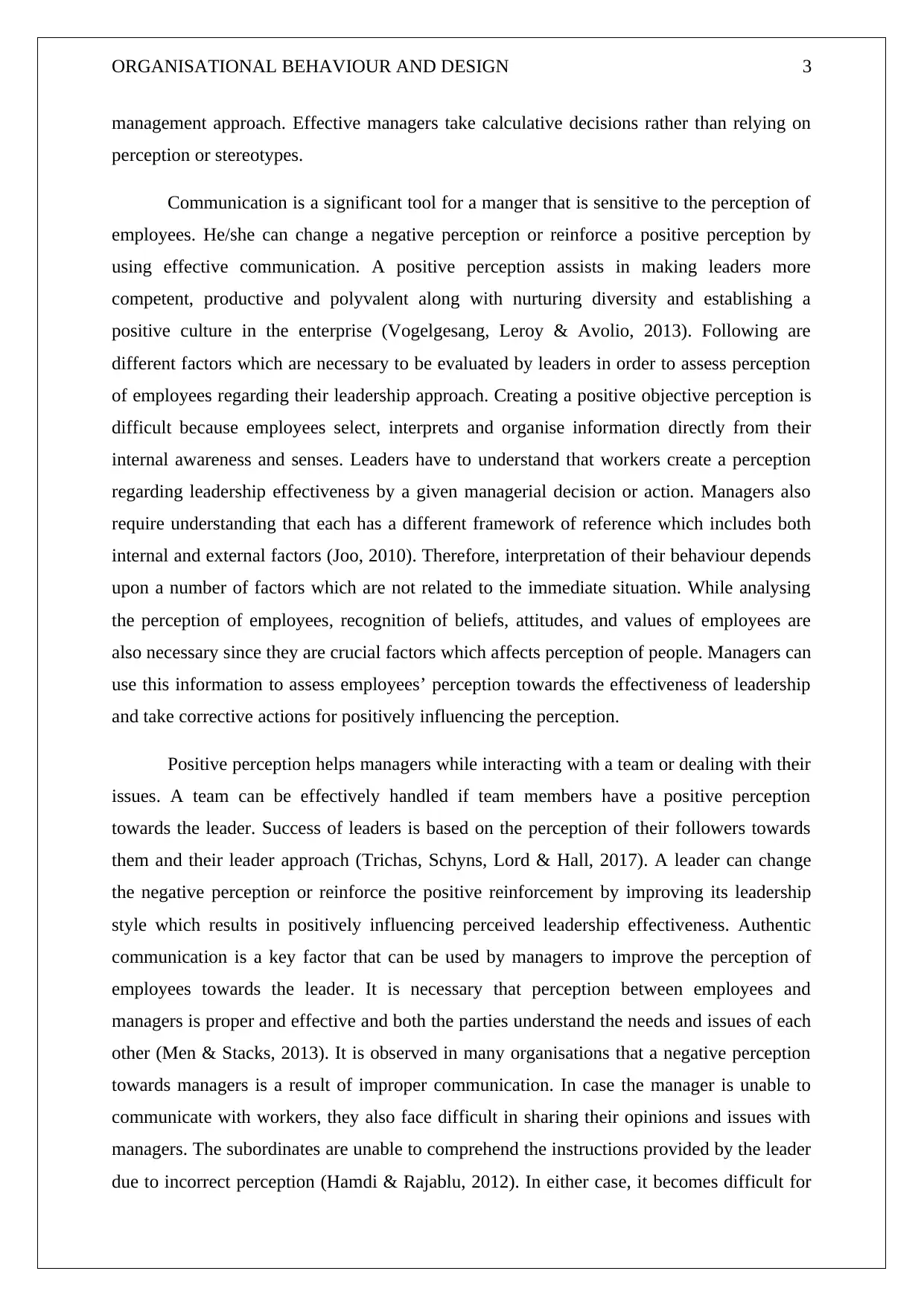
ORGANISATIONAL BEHAVIOUR AND DESIGN 3
management approach. Effective managers take calculative decisions rather than relying on
perception or stereotypes.
Communication is a significant tool for a manger that is sensitive to the perception of
employees. He/she can change a negative perception or reinforce a positive perception by
using effective communication. A positive perception assists in making leaders more
competent, productive and polyvalent along with nurturing diversity and establishing a
positive culture in the enterprise (Vogelgesang, Leroy & Avolio, 2013). Following are
different factors which are necessary to be evaluated by leaders in order to assess perception
of employees regarding their leadership approach. Creating a positive objective perception is
difficult because employees select, interprets and organise information directly from their
internal awareness and senses. Leaders have to understand that workers create a perception
regarding leadership effectiveness by a given managerial decision or action. Managers also
require understanding that each has a different framework of reference which includes both
internal and external factors (Joo, 2010). Therefore, interpretation of their behaviour depends
upon a number of factors which are not related to the immediate situation. While analysing
the perception of employees, recognition of beliefs, attitudes, and values of employees are
also necessary since they are crucial factors which affects perception of people. Managers can
use this information to assess employees’ perception towards the effectiveness of leadership
and take corrective actions for positively influencing the perception.
Positive perception helps managers while interacting with a team or dealing with their
issues. A team can be effectively handled if team members have a positive perception
towards the leader. Success of leaders is based on the perception of their followers towards
them and their leader approach (Trichas, Schyns, Lord & Hall, 2017). A leader can change
the negative perception or reinforce the positive reinforcement by improving its leadership
style which results in positively influencing perceived leadership effectiveness. Authentic
communication is a key factor that can be used by managers to improve the perception of
employees towards the leader. It is necessary that perception between employees and
managers is proper and effective and both the parties understand the needs and issues of each
other (Men & Stacks, 2013). It is observed in many organisations that a negative perception
towards managers is a result of improper communication. In case the manager is unable to
communicate with workers, they also face difficult in sharing their opinions and issues with
managers. The subordinates are unable to comprehend the instructions provided by the leader
due to incorrect perception (Hamdi & Rajablu, 2012). In either case, it becomes difficult for
management approach. Effective managers take calculative decisions rather than relying on
perception or stereotypes.
Communication is a significant tool for a manger that is sensitive to the perception of
employees. He/she can change a negative perception or reinforce a positive perception by
using effective communication. A positive perception assists in making leaders more
competent, productive and polyvalent along with nurturing diversity and establishing a
positive culture in the enterprise (Vogelgesang, Leroy & Avolio, 2013). Following are
different factors which are necessary to be evaluated by leaders in order to assess perception
of employees regarding their leadership approach. Creating a positive objective perception is
difficult because employees select, interprets and organise information directly from their
internal awareness and senses. Leaders have to understand that workers create a perception
regarding leadership effectiveness by a given managerial decision or action. Managers also
require understanding that each has a different framework of reference which includes both
internal and external factors (Joo, 2010). Therefore, interpretation of their behaviour depends
upon a number of factors which are not related to the immediate situation. While analysing
the perception of employees, recognition of beliefs, attitudes, and values of employees are
also necessary since they are crucial factors which affects perception of people. Managers can
use this information to assess employees’ perception towards the effectiveness of leadership
and take corrective actions for positively influencing the perception.
Positive perception helps managers while interacting with a team or dealing with their
issues. A team can be effectively handled if team members have a positive perception
towards the leader. Success of leaders is based on the perception of their followers towards
them and their leader approach (Trichas, Schyns, Lord & Hall, 2017). A leader can change
the negative perception or reinforce the positive reinforcement by improving its leadership
style which results in positively influencing perceived leadership effectiveness. Authentic
communication is a key factor that can be used by managers to improve the perception of
employees towards the leader. It is necessary that perception between employees and
managers is proper and effective and both the parties understand the needs and issues of each
other (Men & Stacks, 2013). It is observed in many organisations that a negative perception
towards managers is a result of improper communication. In case the manager is unable to
communicate with workers, they also face difficult in sharing their opinions and issues with
managers. The subordinates are unable to comprehend the instructions provided by the leader
due to incorrect perception (Hamdi & Rajablu, 2012). In either case, it becomes difficult for
Paraphrase This Document
Need a fresh take? Get an instant paraphrase of this document with our AI Paraphraser
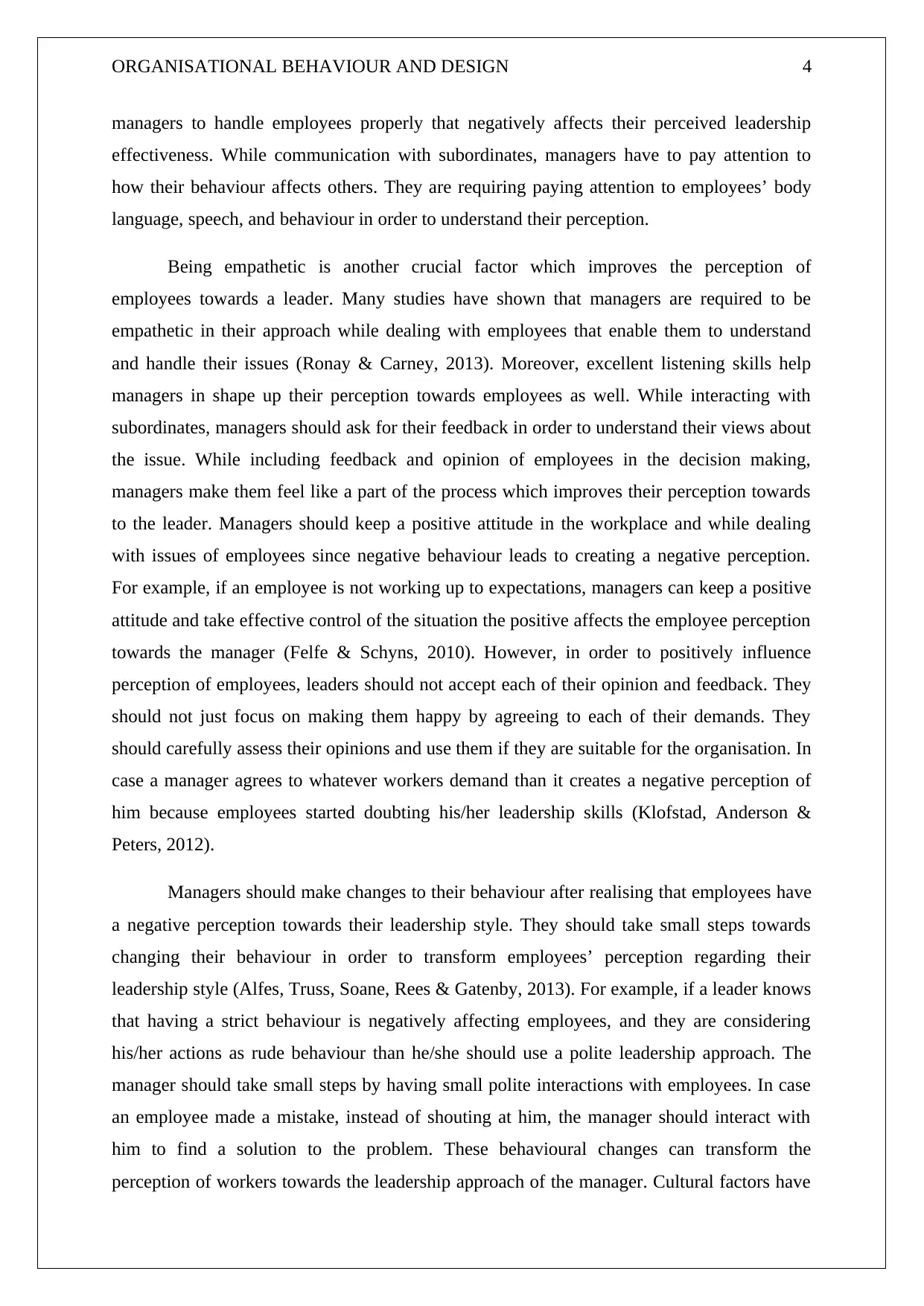
ORGANISATIONAL BEHAVIOUR AND DESIGN 4
managers to handle employees properly that negatively affects their perceived leadership
effectiveness. While communication with subordinates, managers have to pay attention to
how their behaviour affects others. They are requiring paying attention to employees’ body
language, speech, and behaviour in order to understand their perception.
Being empathetic is another crucial factor which improves the perception of
employees towards a leader. Many studies have shown that managers are required to be
empathetic in their approach while dealing with employees that enable them to understand
and handle their issues (Ronay & Carney, 2013). Moreover, excellent listening skills help
managers in shape up their perception towards employees as well. While interacting with
subordinates, managers should ask for their feedback in order to understand their views about
the issue. While including feedback and opinion of employees in the decision making,
managers make them feel like a part of the process which improves their perception towards
to the leader. Managers should keep a positive attitude in the workplace and while dealing
with issues of employees since negative behaviour leads to creating a negative perception.
For example, if an employee is not working up to expectations, managers can keep a positive
attitude and take effective control of the situation the positive affects the employee perception
towards the manager (Felfe & Schyns, 2010). However, in order to positively influence
perception of employees, leaders should not accept each of their opinion and feedback. They
should not just focus on making them happy by agreeing to each of their demands. They
should carefully assess their opinions and use them if they are suitable for the organisation. In
case a manager agrees to whatever workers demand than it creates a negative perception of
him because employees started doubting his/her leadership skills (Klofstad, Anderson &
Peters, 2012).
Managers should make changes to their behaviour after realising that employees have
a negative perception towards their leadership style. They should take small steps towards
changing their behaviour in order to transform employees’ perception regarding their
leadership style (Alfes, Truss, Soane, Rees & Gatenby, 2013). For example, if a leader knows
that having a strict behaviour is negatively affecting employees, and they are considering
his/her actions as rude behaviour than he/she should use a polite leadership approach. The
manager should take small steps by having small polite interactions with employees. In case
an employee made a mistake, instead of shouting at him, the manager should interact with
him to find a solution to the problem. These behavioural changes can transform the
perception of workers towards the leadership approach of the manager. Cultural factors have
managers to handle employees properly that negatively affects their perceived leadership
effectiveness. While communication with subordinates, managers have to pay attention to
how their behaviour affects others. They are requiring paying attention to employees’ body
language, speech, and behaviour in order to understand their perception.
Being empathetic is another crucial factor which improves the perception of
employees towards a leader. Many studies have shown that managers are required to be
empathetic in their approach while dealing with employees that enable them to understand
and handle their issues (Ronay & Carney, 2013). Moreover, excellent listening skills help
managers in shape up their perception towards employees as well. While interacting with
subordinates, managers should ask for their feedback in order to understand their views about
the issue. While including feedback and opinion of employees in the decision making,
managers make them feel like a part of the process which improves their perception towards
to the leader. Managers should keep a positive attitude in the workplace and while dealing
with issues of employees since negative behaviour leads to creating a negative perception.
For example, if an employee is not working up to expectations, managers can keep a positive
attitude and take effective control of the situation the positive affects the employee perception
towards the manager (Felfe & Schyns, 2010). However, in order to positively influence
perception of employees, leaders should not accept each of their opinion and feedback. They
should not just focus on making them happy by agreeing to each of their demands. They
should carefully assess their opinions and use them if they are suitable for the organisation. In
case a manager agrees to whatever workers demand than it creates a negative perception of
him because employees started doubting his/her leadership skills (Klofstad, Anderson &
Peters, 2012).
Managers should make changes to their behaviour after realising that employees have
a negative perception towards their leadership style. They should take small steps towards
changing their behaviour in order to transform employees’ perception regarding their
leadership style (Alfes, Truss, Soane, Rees & Gatenby, 2013). For example, if a leader knows
that having a strict behaviour is negatively affecting employees, and they are considering
his/her actions as rude behaviour than he/she should use a polite leadership approach. The
manager should take small steps by having small polite interactions with employees. In case
an employee made a mistake, instead of shouting at him, the manager should interact with
him to find a solution to the problem. These behavioural changes can transform the
perception of workers towards the leadership approach of the manager. Cultural factors have
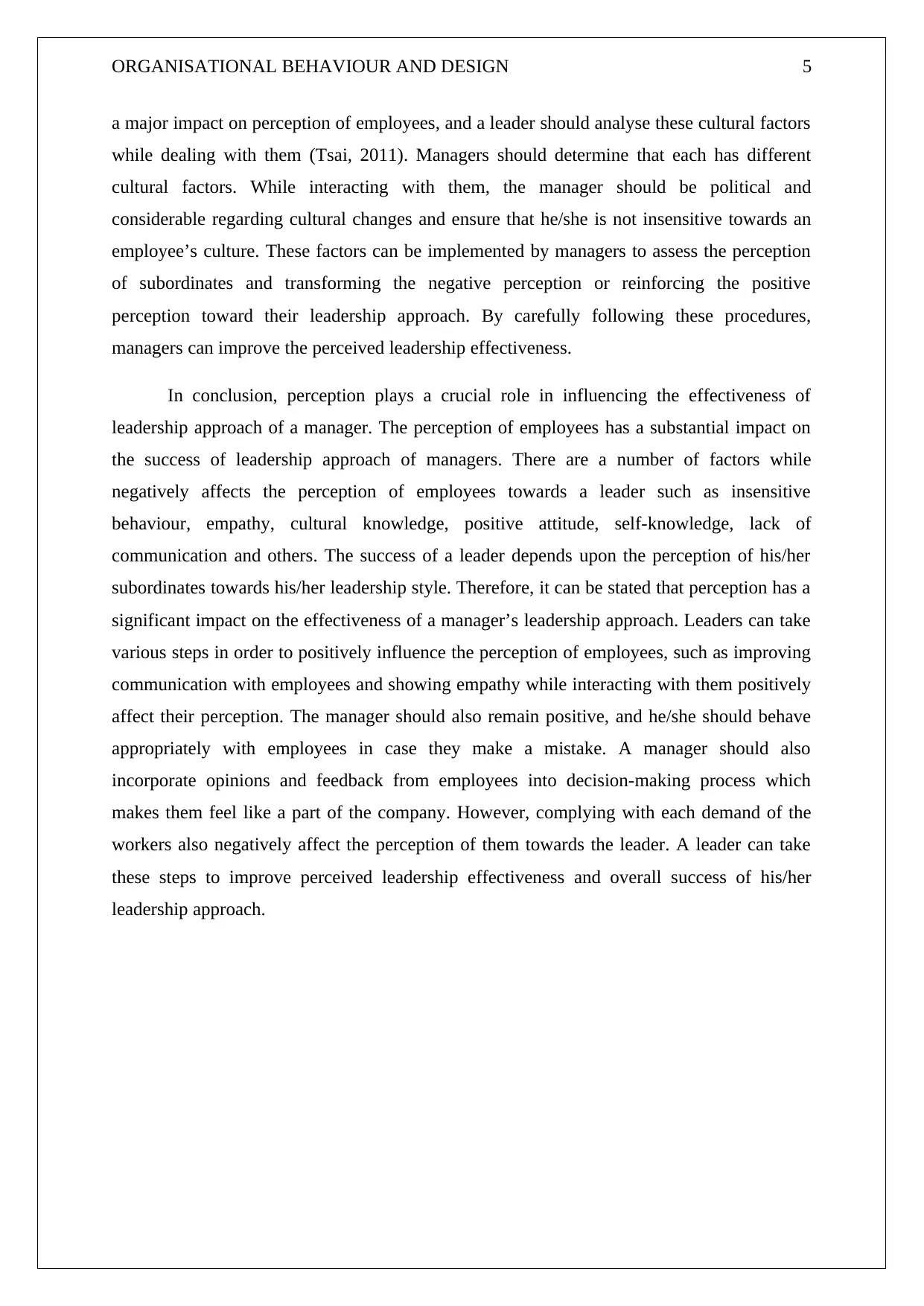
ORGANISATIONAL BEHAVIOUR AND DESIGN 5
a major impact on perception of employees, and a leader should analyse these cultural factors
while dealing with them (Tsai, 2011). Managers should determine that each has different
cultural factors. While interacting with them, the manager should be political and
considerable regarding cultural changes and ensure that he/she is not insensitive towards an
employee’s culture. These factors can be implemented by managers to assess the perception
of subordinates and transforming the negative perception or reinforcing the positive
perception toward their leadership approach. By carefully following these procedures,
managers can improve the perceived leadership effectiveness.
In conclusion, perception plays a crucial role in influencing the effectiveness of
leadership approach of a manager. The perception of employees has a substantial impact on
the success of leadership approach of managers. There are a number of factors while
negatively affects the perception of employees towards a leader such as insensitive
behaviour, empathy, cultural knowledge, positive attitude, self-knowledge, lack of
communication and others. The success of a leader depends upon the perception of his/her
subordinates towards his/her leadership style. Therefore, it can be stated that perception has a
significant impact on the effectiveness of a manager’s leadership approach. Leaders can take
various steps in order to positively influence the perception of employees, such as improving
communication with employees and showing empathy while interacting with them positively
affect their perception. The manager should also remain positive, and he/she should behave
appropriately with employees in case they make a mistake. A manager should also
incorporate opinions and feedback from employees into decision-making process which
makes them feel like a part of the company. However, complying with each demand of the
workers also negatively affect the perception of them towards the leader. A leader can take
these steps to improve perceived leadership effectiveness and overall success of his/her
leadership approach.
a major impact on perception of employees, and a leader should analyse these cultural factors
while dealing with them (Tsai, 2011). Managers should determine that each has different
cultural factors. While interacting with them, the manager should be political and
considerable regarding cultural changes and ensure that he/she is not insensitive towards an
employee’s culture. These factors can be implemented by managers to assess the perception
of subordinates and transforming the negative perception or reinforcing the positive
perception toward their leadership approach. By carefully following these procedures,
managers can improve the perceived leadership effectiveness.
In conclusion, perception plays a crucial role in influencing the effectiveness of
leadership approach of a manager. The perception of employees has a substantial impact on
the success of leadership approach of managers. There are a number of factors while
negatively affects the perception of employees towards a leader such as insensitive
behaviour, empathy, cultural knowledge, positive attitude, self-knowledge, lack of
communication and others. The success of a leader depends upon the perception of his/her
subordinates towards his/her leadership style. Therefore, it can be stated that perception has a
significant impact on the effectiveness of a manager’s leadership approach. Leaders can take
various steps in order to positively influence the perception of employees, such as improving
communication with employees and showing empathy while interacting with them positively
affect their perception. The manager should also remain positive, and he/she should behave
appropriately with employees in case they make a mistake. A manager should also
incorporate opinions and feedback from employees into decision-making process which
makes them feel like a part of the company. However, complying with each demand of the
workers also negatively affect the perception of them towards the leader. A leader can take
these steps to improve perceived leadership effectiveness and overall success of his/her
leadership approach.
⊘ This is a preview!⊘
Do you want full access?
Subscribe today to unlock all pages.

Trusted by 1+ million students worldwide
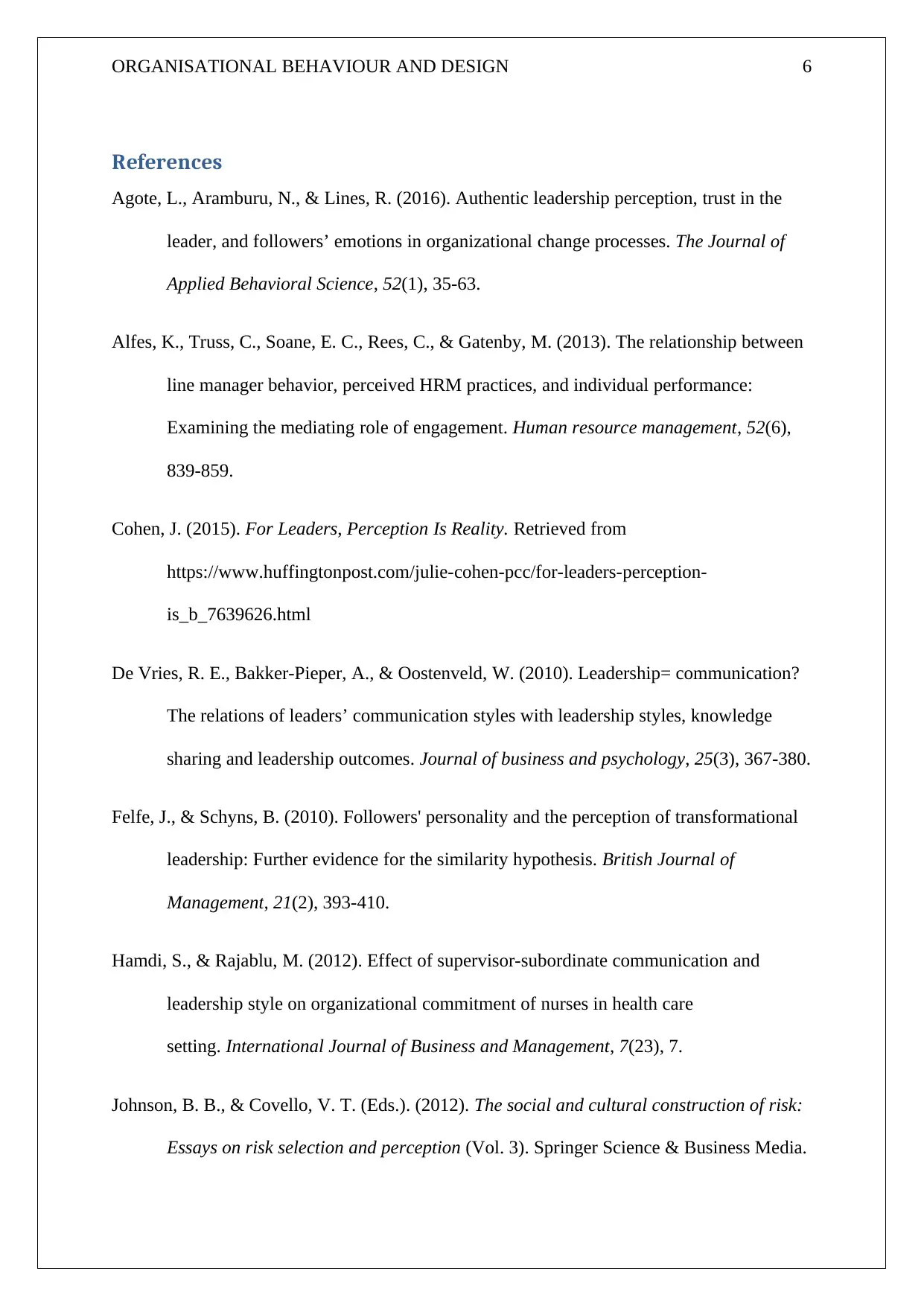
ORGANISATIONAL BEHAVIOUR AND DESIGN 6
References
Agote, L., Aramburu, N., & Lines, R. (2016). Authentic leadership perception, trust in the
leader, and followers’ emotions in organizational change processes. The Journal of
Applied Behavioral Science, 52(1), 35-63.
Alfes, K., Truss, C., Soane, E. C., Rees, C., & Gatenby, M. (2013). The relationship between
line manager behavior, perceived HRM practices, and individual performance:
Examining the mediating role of engagement. Human resource management, 52(6),
839-859.
Cohen, J. (2015). For Leaders, Perception Is Reality. Retrieved from
https://www.huffingtonpost.com/julie-cohen-pcc/for-leaders-perception-
is_b_7639626.html
De Vries, R. E., Bakker-Pieper, A., & Oostenveld, W. (2010). Leadership= communication?
The relations of leaders’ communication styles with leadership styles, knowledge
sharing and leadership outcomes. Journal of business and psychology, 25(3), 367-380.
Felfe, J., & Schyns, B. (2010). Followers' personality and the perception of transformational
leadership: Further evidence for the similarity hypothesis. British Journal of
Management, 21(2), 393-410.
Hamdi, S., & Rajablu, M. (2012). Effect of supervisor-subordinate communication and
leadership style on organizational commitment of nurses in health care
setting. International Journal of Business and Management, 7(23), 7.
Johnson, B. B., & Covello, V. T. (Eds.). (2012). The social and cultural construction of risk:
Essays on risk selection and perception (Vol. 3). Springer Science & Business Media.
References
Agote, L., Aramburu, N., & Lines, R. (2016). Authentic leadership perception, trust in the
leader, and followers’ emotions in organizational change processes. The Journal of
Applied Behavioral Science, 52(1), 35-63.
Alfes, K., Truss, C., Soane, E. C., Rees, C., & Gatenby, M. (2013). The relationship between
line manager behavior, perceived HRM practices, and individual performance:
Examining the mediating role of engagement. Human resource management, 52(6),
839-859.
Cohen, J. (2015). For Leaders, Perception Is Reality. Retrieved from
https://www.huffingtonpost.com/julie-cohen-pcc/for-leaders-perception-
is_b_7639626.html
De Vries, R. E., Bakker-Pieper, A., & Oostenveld, W. (2010). Leadership= communication?
The relations of leaders’ communication styles with leadership styles, knowledge
sharing and leadership outcomes. Journal of business and psychology, 25(3), 367-380.
Felfe, J., & Schyns, B. (2010). Followers' personality and the perception of transformational
leadership: Further evidence for the similarity hypothesis. British Journal of
Management, 21(2), 393-410.
Hamdi, S., & Rajablu, M. (2012). Effect of supervisor-subordinate communication and
leadership style on organizational commitment of nurses in health care
setting. International Journal of Business and Management, 7(23), 7.
Johnson, B. B., & Covello, V. T. (Eds.). (2012). The social and cultural construction of risk:
Essays on risk selection and perception (Vol. 3). Springer Science & Business Media.
Paraphrase This Document
Need a fresh take? Get an instant paraphrase of this document with our AI Paraphraser
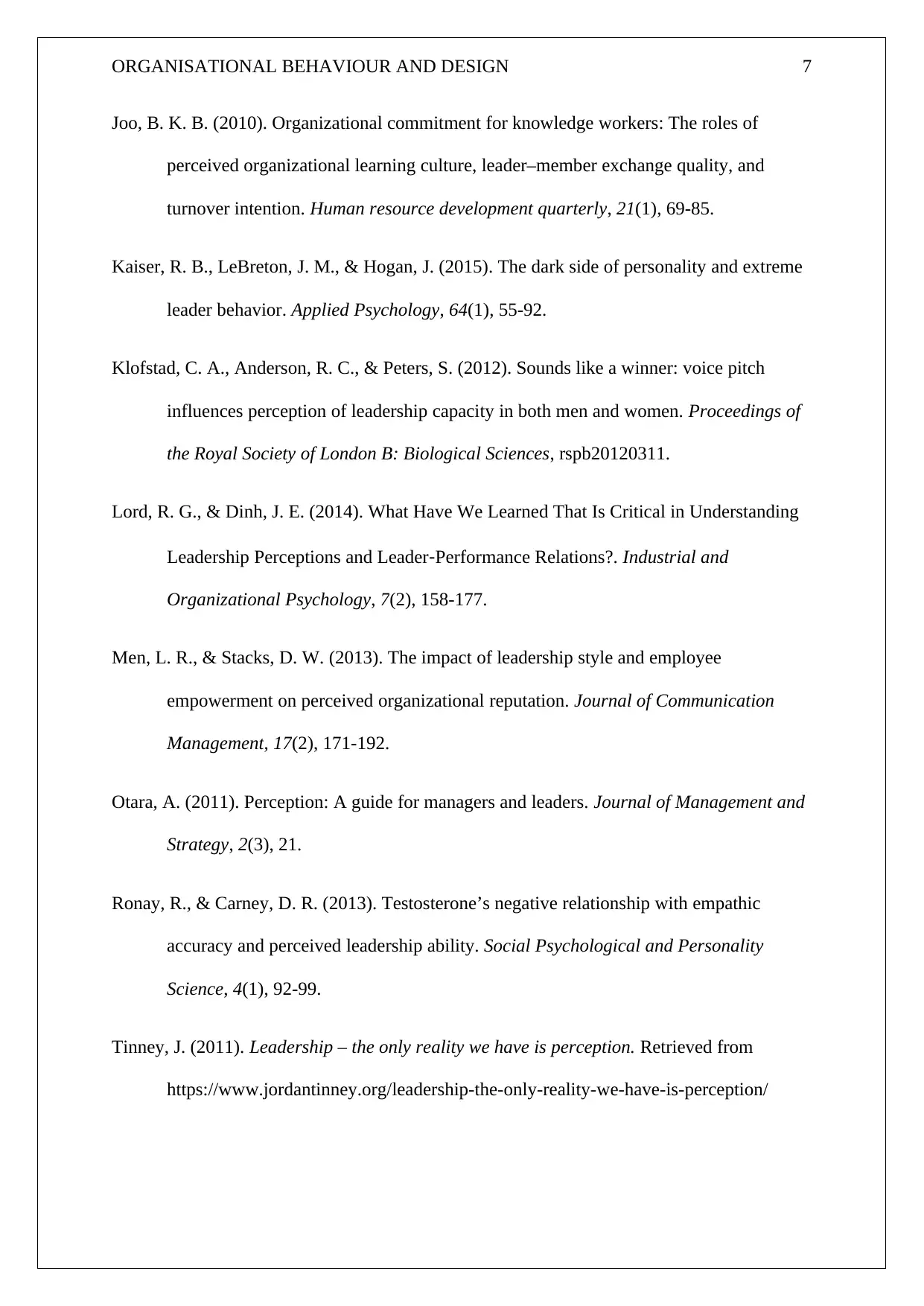
ORGANISATIONAL BEHAVIOUR AND DESIGN 7
Joo, B. K. B. (2010). Organizational commitment for knowledge workers: The roles of
perceived organizational learning culture, leader–member exchange quality, and
turnover intention. Human resource development quarterly, 21(1), 69-85.
Kaiser, R. B., LeBreton, J. M., & Hogan, J. (2015). The dark side of personality and extreme
leader behavior. Applied Psychology, 64(1), 55-92.
Klofstad, C. A., Anderson, R. C., & Peters, S. (2012). Sounds like a winner: voice pitch
influences perception of leadership capacity in both men and women. Proceedings of
the Royal Society of London B: Biological Sciences, rspb20120311.
Lord, R. G., & Dinh, J. E. (2014). What Have We Learned That Is Critical in Understanding
Leadership Perceptions and Leader‐Performance Relations?. Industrial and
Organizational Psychology, 7(2), 158-177.
Men, L. R., & Stacks, D. W. (2013). The impact of leadership style and employee
empowerment on perceived organizational reputation. Journal of Communication
Management, 17(2), 171-192.
Otara, A. (2011). Perception: A guide for managers and leaders. Journal of Management and
Strategy, 2(3), 21.
Ronay, R., & Carney, D. R. (2013). Testosterone’s negative relationship with empathic
accuracy and perceived leadership ability. Social Psychological and Personality
Science, 4(1), 92-99.
Tinney, J. (2011). Leadership – the only reality we have is perception. Retrieved from
https://www.jordantinney.org/leadership-the-only-reality-we-have-is-perception/
Joo, B. K. B. (2010). Organizational commitment for knowledge workers: The roles of
perceived organizational learning culture, leader–member exchange quality, and
turnover intention. Human resource development quarterly, 21(1), 69-85.
Kaiser, R. B., LeBreton, J. M., & Hogan, J. (2015). The dark side of personality and extreme
leader behavior. Applied Psychology, 64(1), 55-92.
Klofstad, C. A., Anderson, R. C., & Peters, S. (2012). Sounds like a winner: voice pitch
influences perception of leadership capacity in both men and women. Proceedings of
the Royal Society of London B: Biological Sciences, rspb20120311.
Lord, R. G., & Dinh, J. E. (2014). What Have We Learned That Is Critical in Understanding
Leadership Perceptions and Leader‐Performance Relations?. Industrial and
Organizational Psychology, 7(2), 158-177.
Men, L. R., & Stacks, D. W. (2013). The impact of leadership style and employee
empowerment on perceived organizational reputation. Journal of Communication
Management, 17(2), 171-192.
Otara, A. (2011). Perception: A guide for managers and leaders. Journal of Management and
Strategy, 2(3), 21.
Ronay, R., & Carney, D. R. (2013). Testosterone’s negative relationship with empathic
accuracy and perceived leadership ability. Social Psychological and Personality
Science, 4(1), 92-99.
Tinney, J. (2011). Leadership – the only reality we have is perception. Retrieved from
https://www.jordantinney.org/leadership-the-only-reality-we-have-is-perception/
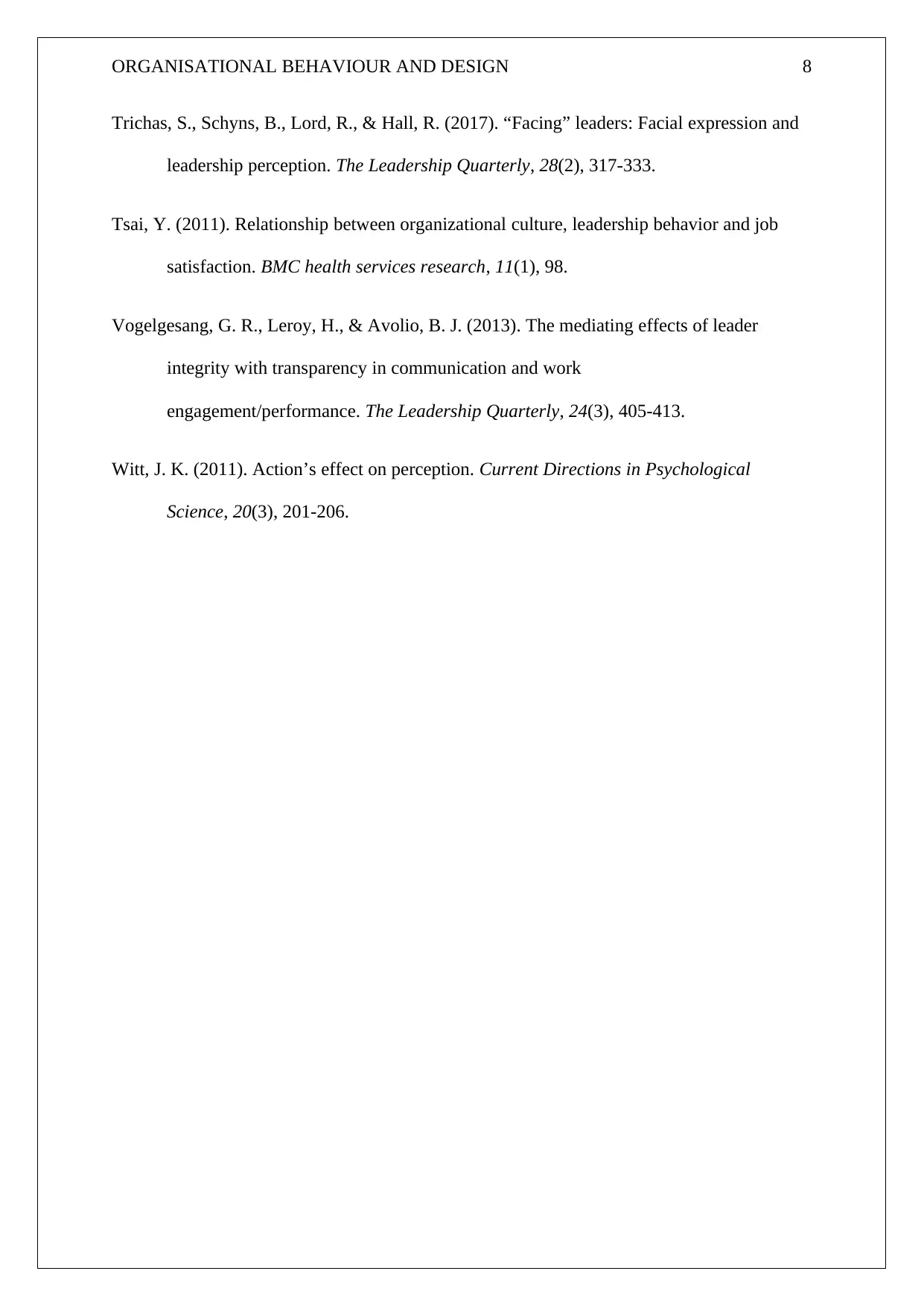
ORGANISATIONAL BEHAVIOUR AND DESIGN 8
Trichas, S., Schyns, B., Lord, R., & Hall, R. (2017). “Facing” leaders: Facial expression and
leadership perception. The Leadership Quarterly, 28(2), 317-333.
Tsai, Y. (2011). Relationship between organizational culture, leadership behavior and job
satisfaction. BMC health services research, 11(1), 98.
Vogelgesang, G. R., Leroy, H., & Avolio, B. J. (2013). The mediating effects of leader
integrity with transparency in communication and work
engagement/performance. The Leadership Quarterly, 24(3), 405-413.
Witt, J. K. (2011). Action’s effect on perception. Current Directions in Psychological
Science, 20(3), 201-206.
Trichas, S., Schyns, B., Lord, R., & Hall, R. (2017). “Facing” leaders: Facial expression and
leadership perception. The Leadership Quarterly, 28(2), 317-333.
Tsai, Y. (2011). Relationship between organizational culture, leadership behavior and job
satisfaction. BMC health services research, 11(1), 98.
Vogelgesang, G. R., Leroy, H., & Avolio, B. J. (2013). The mediating effects of leader
integrity with transparency in communication and work
engagement/performance. The Leadership Quarterly, 24(3), 405-413.
Witt, J. K. (2011). Action’s effect on perception. Current Directions in Psychological
Science, 20(3), 201-206.
⊘ This is a preview!⊘
Do you want full access?
Subscribe today to unlock all pages.

Trusted by 1+ million students worldwide
1 out of 9
Related Documents
Your All-in-One AI-Powered Toolkit for Academic Success.
+13062052269
info@desklib.com
Available 24*7 on WhatsApp / Email
![[object Object]](/_next/static/media/star-bottom.7253800d.svg)
Unlock your academic potential
Copyright © 2020–2025 A2Z Services. All Rights Reserved. Developed and managed by ZUCOL.





